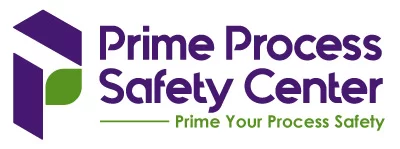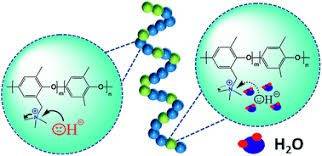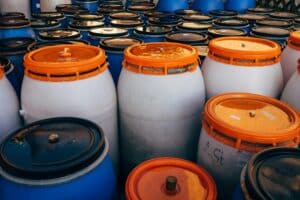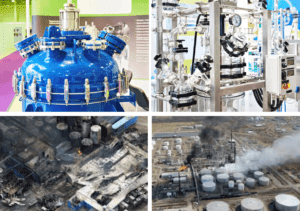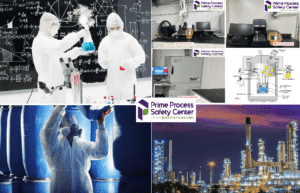We also offer
Chemical Instability Studies
Understanding the potential occurrence of chemical instabilities—such as reactions leading to hazardous conditions—is crucial for maintaining a safe working environment. Chemical instability studies provide valuable insights into the behavior of reactive substances, their reactivity limits, and the conditions that may lead to undesired reactions.
Understanding Chemical Instability Studies
Chemical instability studies focus on investigating the conditions that can lead to unsafe and uncontrolled reactions in a chemical process.
They analyze the reactivity of reactive substances under various operating conditions, including temperature, pressure, and concentration. By identifying the limits and tendencies for potentially hazardous reactions, these studies actively contribute to preventing accidents and ensuring operational safety.
Application of Chemical Instability Studies in Process Safety
Identification of Reactive Substances
Chemical instability studies help in detecting and identifying substances that possess significant reactivity risks. By understanding the factors that contribute to their instability—such as sensitivity to friction, heat, or contact with other chemicals—industries can take appropriate precautionary measures to ensure safe handling, storage, and transportation of these substances.
Identifying reactive substances early allows for the implementation of specific safety protocols and guidelines to mitigate risks effectively.
Storage and Handling Precautions
Chemical instability studies aid in establishing appropriate storage and handling methods for reactive substances. By understanding the conditions that may trigger undesired reactions, such as temperature limits, incompatible storage materials, or moisture sensitivity, industries can implement measures to minimize the risk of fire, explosion, or toxic release.
By adhering to recommended storage and handling practices, organizations can significantly reduce the likelihood of accidents during these processes.
Process Design and Optimization
Chemical instability studies guide the design and optimization of industrial processes. By examining the effects of process variables—such as temperature, pressure, and reaction time—industries can ensure that operating conditions remain within safe boundaries.
These studies assist in identifying critical parameters that may induce uncontrollable reactions, facilitating the implementation of safety controls. Process optimization driven by chemical instability studies promotes safer operation while improving process efficiency.
Incident Prevention and Emergency Response Planning
An in-depth understanding of chemical instabilities empowers industries to establish comprehensive incident prevention and emergency response plans. By evaluating potential reaction scenarios and performing consequence analyses, industries can develop effective prevention and mitigation strategies.
This includes engineering controls, administrative controls, emergency evacuation plans, and first responder guidelines. Chemical instability studies provide valuable insights that help organizations minimize risks and respond promptly to unfavorable events.
Regulatory Compliance
Chemical instability studies play a vital role in ensuring regulatory compliance. By demonstrating thorough assessment of reactive substances and implementing preventive measures, industries can meet the requirements set by government agencies and advocacy groups.
Compliance with regulations underscores safe manufacturing, storage, and handling practices while also promoting public confidence and trust.
Why Perform Chemical Instability Studies
Chemical instability studies serve as a critical tool in minimizing risks associated with the handling and storage of reactive substances, thereby strengthening process safety in diverse industries.
Through the identification of reactive substances, implementation of safe storage and handling practices, optimization of industrial processes, emergency preparedness, and adherence to regulatory requirements, organizations can proactively manage potential chemical instabilities.
By prioritizing chemical instability studies, industries can protect personnel and assets, ensure process reliability, and maintain a sustainable and secure working environment.
Why Choose Prime Process Safety Center
At Prime Process Safety Center, we specialize in identifying and mitigating challenges associated with chemical instability across industries.
-
Expertise in Chemical Instability: Our skilled team employs advanced techniques to assess contributing factors such as temperature, pressure, and chemical interactions.
-
Comprehensive Testing and Analysis: Through detailed testing and data interpretation, we uncover potential issues that could compromise product integrity or process safety.
- Accredited Reliability: Our work is supported by an ISO/IEC 17025:2017 accredited laboratory, ensuring the highest level of technical competence and data quality.
-
Tailored Solutions: We customize our approach to address your specific process requirements, ensuring compliance with safety standards and the protection of personnel.
-
Industry Application: Whether in chemical manufacturing, storage, or transportation, our chemical instability services provide a complete understanding of potential risks.
Partner with Prime Process Safety Center to strengthen your operations, enhance product reliability, and cultivate a safe working environment in the face of chemical instability challenges.
FAQ
1. What is a chemical instability study?
A chemical instability study involves assessing the potential for undesired chemical reactions, decomposition, or instability of substances used within industrial processes. It aims to identify and mitigate hazards associated with unstable or reactive materials.
2. Why is chemical instability study important?
A chemical instability study helps identify potential risks and hazards associated with unstable chemicals, reactive mixtures, and conditions that could lead to uncontrolled reactions, explosions, or release of hazardous substances. It allows for appropriate measures to be implemented to ensure process safety.
3. How is a chemical instability study conducted?
A chemical instability study typically involves laboratory tests, literature reviews, and chemical compatibility assessments. It may also utilize computer modeling techniques to evaluate reaction pathways, assess thermodynamic data, and determine potential hazards.
4. What factors are considered in a chemical instability study?
Factors considered in a chemical instability study include temperature, pressure, presence of catalysts, concentration of reactive substances, initiation sources, thermal effects, or any conditions that might trigger or promote hazardous reactions.
5. What are the potential hazards that a chemical instability study can help identify?
A chemical instability study can help identify hazards such as thermal decomposition, self-reactive substances, autocatalysis, autoignition, polymerization, explosive reactions, or release of toxic gases associated with unstable chemicals or reactive mixtures.
6. How can a chemical instability study improve process safety?
By assessing the potential risks and hazards associated with chemical instability, industry professionals can implement appropriate design measures, select compatible materials, establish safe operating conditions, and develop emergency response plans to mitigate process safety risks.
7. Are there any regulations or guidelines related to chemical instability studies?
Regulatory bodies such as OSHA, EPA, or national authorities may have specific requirements or guidelines related to chemical instability studies. Additionally, industry organizations or standards like NFPA, API, or ICC may offer recommendations for conducting these studies.
8. How often should a chemical instability study be conducted?
A chemical instability study should be conducted during the design phase of a process, whenever new chemicals or mixtures are introduced, or when significant changes occur within the process conditions or materials. Regular review and updates may be required to ensure ongoing process safety.
9. Can computer modeling be used for chemical instability studies?
Yes, computer modeling can be used to simulate potential reactions, estimate reaction rates, assess energy release, predict reaction products, and evaluate various scenarios to better understand and manage chemical instability.
10. Can outsourcing a chemical instability study help industries?
Yes, outsourcing a chemical instability study to specialized consultants or experts can provide access to extensive knowledge, expertise, and state-of-the-art tools required for thorough evaluation. It can ensure comprehensive analysis and recommendations for enhancing process safety.

